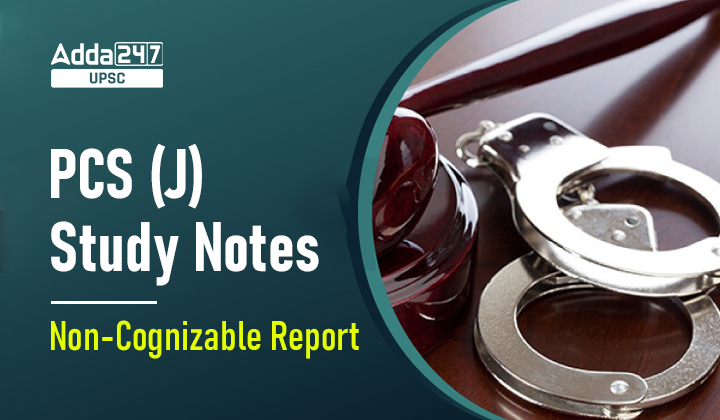Table of Contents
Non-Cognizable Report
When a suspect in a non-cognizable crime contacts the officer in charge, the officer records the details of the encounter in a notebook (maintained as per the format prescribed by the State Government). Second, a police officer can’t start investigating a non-cognizable offence without a court order (under section 155(3) of the CrPC). A police officer needs a magistrate’s approval before pursuing a non-cognizable case. The Criminal Procedure Code has a provision for this exact situation in Section 155(2). Except for the ability to make an arrest without a warrant, a police officer has the same investigative authorities in both cognizable and non-cognizable offences.
A criminal complaint is filed with the metropolitan magistrate or the Judicial Magistrate of competent jurisdiction, and they are required to direct the local police department to open an investigation. The officer submits a charge sheet to the court, and then there is a hearing. If the accused is proven guilty at trial, the judge will issue an arrest warrant.
Non-cognizable offence
A “non-cognizable offence” is a crime for which a police officer does not have the authority to make an arrest without a warrant. The Indian Penal Code defines non-cognizable offences as those that appear in schedule 1 and are hence subject to bail. In the event of a non-cognizable offence, law enforcement agency is not authorised to initiate an investigation or make an arrest without a warrant. Non-cognizable crimes include things like forgery, cheating, slander, public nuisance, and so on.
Case laws
In the case of Public Prosecutor v. Ratnavelu Chetty (1926), the Supreme Court ruled that the police must notify the magistrate if they obtain information about a crime that does not meet the criteria for “cognizable” status. A court procedure may be opened only by a magistrate. However, a sworn statement and other formalities must be performed when a complaint is filed before a magistrate. According to Section 203 of the Code of Criminal Procedure, 1973, a magistrate may also decide to reject a complaint.
The Court clarified police authority in cases of non-cognizable offences in Om Prakash and Anr v. Union of India (2011). They said that the excise officer, like any other police officer, needs a warrant to make an arrest. Section 41 of the Code of Criminal Procedure, 1973, which details when police can make an arrest with or without a warrant, contains identical language.
In the case of Dr. Kamal Kishore Kalra v. State of NCT of Delhi (2008), the Court ruled that “a police investigation report can be treated as a complaint made by a police officer if the investigation was initially conducted under the procedure of a cognizable offence but later turned out to be a non-cognizable offence”.
गैर-संज्ञेय रिपोर्ट
जब एक असंज्ञेय अपराध में एक संदिग्ध व्यक्ति प्रभारी अधिकारी से संपर्क करता है, तो अधिकारी एक नोटबुक में मुठभेड़ का विवरण दर्ज करता है (राज्य सरकार द्वारा निर्धारित प्रारूप के अनुसार बनाए रखा जाता है)। दूसरा, एक पुलिस अधिकारी अदालत के आदेश (सीआरपीसी की धारा 155(3) के तहत) के बिना एक गैर-संज्ञेय अपराध की जांच शुरू नहीं कर सकता है। एक गैर-संज्ञेय मामले को आगे बढ़ाने से पहले एक पुलिस अधिकारी को मजिस्ट्रेट की मंजूरी की आवश्यकता होती है। दंड प्रक्रिया संहिता की धारा 155(2) में इस सटीक स्थिति का प्रावधान है। वारंट के बिना गिरफ्तारी करने की क्षमता को छोड़कर, एक पुलिस अधिकारी के पास संज्ञेय और गैर-संज्ञेय दोनों तरह के अपराधों में एक ही जांच अधिकारी होते हैं।
एक आपराधिक शिकायत मेट्रोपॉलिटन मजिस्ट्रेट या सक्षम अधिकार क्षेत्र के न्यायिक मजिस्ट्रेट के पास दर्ज की जाती है, और उन्हें स्थानीय पुलिस विभाग को जांच शुरू करने का निर्देश देना होता है। अधिकारी अदालत में चार्जशीट पेश करता है, और फिर सुनवाई होती है। यदि आरोपी मुकदमे में दोषी साबित होता है, तो न्यायाधीश गिरफ्तारी वारंट जारी करेगा।
गैर-संज्ञेय अपराध
एक “गैर-संज्ञेय अपराध” एक ऐसा अपराध है जिसके लिए एक पुलिस अधिकारी के पास वारंट के बिना गिरफ्तारी करने का अधिकार नहीं होता है। भारतीय दंड संहिता गैर-संज्ञेय अपराधों को उन अपराधों के रूप में परिभाषित करती है जो अनुसूची 1 में दिखाई देते हैं और इसलिए जमानत के अधीन हैं। गैर-संज्ञेय अपराध की स्थिति में, कानून प्रवर्तन एजेंसी बिना वारंट के जांच शुरू करने या गिरफ्तारी करने के लिए अधिकृत नहीं है। गैर-संज्ञेय अपराधों में जालसाजी, धोखाधड़ी, बदनामी, सार्वजनिक उपद्रव आदि जैसी चीजें शामिल हैं।
केस कानून
लोक अभियोजक बनाम रत्नावेलु चेट्टी (1926) के मामले में, सुप्रीम कोर्ट ने फैसला सुनाया कि पुलिस को मजिस्ट्रेट को सूचित करना चाहिए यदि वे किसी ऐसे अपराध के बारे में जानकारी प्राप्त करते हैं जो “संज्ञेय” स्थिति के मानदंडों को पूरा नहीं करता है। एक अदालत की प्रक्रिया केवल एक मजिस्ट्रेट द्वारा खोली जा सकती है। हालांकि, जब एक मजिस्ट्रेट के समक्ष शिकायत दर्ज की जाती है तो शपथ पत्र और अन्य औपचारिकताएं पूरी की जानी चाहिए। दंड प्रक्रिया संहिता, 1973 की धारा 203 के अनुसार, एक मजिस्ट्रेट एक शिकायत को अस्वीकार करने का निर्णय भी ले सकता है।
न्यायालय ने ओम प्रकाश और भारत बनाम भारत संघ (2011) में असंज्ञेय अपराधों के मामलों में पुलिस अधिकार को स्पष्ट किया। उन्होंने कहा कि किसी भी अन्य पुलिस अधिकारी की तरह आबकारी अधिकारी को भी गिरफ्तारी के लिए वारंट की आवश्यकता होती है। दंड प्रक्रिया संहिता, 1973 की धारा 41, जिसमें यह विवरण दिया गया है कि पुलिस वारंट के साथ या उसके बिना गिरफ्तारी कब कर सकती है, में समान भाषा है।
डॉ कमल किशोर कालरा बनाम दिल्ली के एनसीटी राज्य (2008) के मामले में, अदालत ने फैसला सुनाया कि “एक पुलिस जांच रिपोर्ट को एक पुलिस अधिकारी द्वारा की गई शिकायत के रूप में माना जा सकता है यदि जांच शुरू में की प्रक्रिया के तहत आयोजित की गई थी। एक संज्ञेय अपराध लेकिन बाद में एक गैर-संज्ञेय अपराध बन गया”।



 TSPSC Group 1 Question Paper 2024, Downl...
TSPSC Group 1 Question Paper 2024, Downl...
 TSPSC Group 1 Answer key 2024 Out, Downl...
TSPSC Group 1 Answer key 2024 Out, Downl...
 UPSC Prelims 2024 Question Paper, Downlo...
UPSC Prelims 2024 Question Paper, Downlo...





